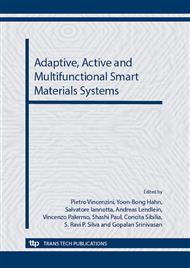p.246
p.253
p.258
p.266
p.270
p.276
p.280
p.285
p.291
Dielectric-Tuned Diamondlike Carbon Materials for an Ultrahigh-Speed Self-Aligned Graphene Channel Field Effect Transistor
Abstract:
The ‘DLC-GFET’, a graphene-channel field effect transistor with a diamondlike carbon (DLC) top-gate dielectric film, is presented. The DLC film was formed ‘directly’ onto the graphene channel without forming passivation interlayers using our photoemission-assisted plasma-enhanced chemical vapor deposition (PA-CVD), where the plasma was precisely controlled by significant photoemission from the sample with quite low electric power, minimizing plasma damage to the channel. The DLC-GFET exhibits clear ambipolar characteristics with a slightly positive shift of the neutral points (Dirac voltages). Relatively high transconductances were obtained as 14.6 (8.8) mS/mm in the n (p) channel modes, respectively, with a thick DLC gate dielectric of 48 nm and a long gate length of 5 μm, promising vertical scaling-down to improve the high-frequency performance. The positive shift of the Dirac voltage is due to unintentional hole doping from an oxygen species like H2O in the DLC film into the graphene channel, suggesting that a modulation-doped DLC structure with a δ-doped oxygen (nitrogen) species for the p (n) mode will overcome high access resistance.
Info:
Periodical:
Pages:
270-275
Citation:
Online since:
September 2012
Price:
Сopyright:
© 2013 Trans Tech Publications Ltd. All Rights Reserved
Share:
Citation:



